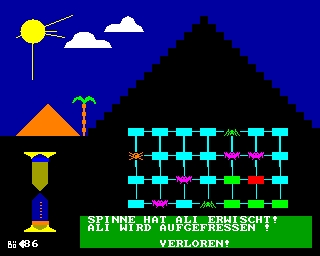- Details
- Geschrieben von Super User
- Hauptkategorie: Magazines
- Kategorie: CFOG's PIP
- Veröffentlicht: 30. November 1987
- Zugriffe: 16721
CFOG's PIP, January 1986, Volume 4 No. 3, Whole No. 39, page 5
SUPERCALC AGAIN
by Hanns Trostli, Box 471, 13300 Itu/SP, Brazil
The May-June edition of PIP published my letter named "MY SFKS FOR SUPERCALC 2". Well, friends, I did not know then but learned the hard way that some caution should be taken when saving the file without backup.
Let me tell you what happened -- it may happen to anybody. The other day I made up a complicated spreadsheet and suddenly a power failure wiped out what was on my screen. Eager to finish I hadn't made any intermediate saving of the file. So I started again, saving the file often with my SFK#4 for saving without backup. And then the incredible happened: changing to another file I zapped the screen and then, instead hitting SFK#3 (/LB:) I hit SFK#4 again and saved the blank screen! Having learned from this I cancelled SFK#4 and am using only SFK#I, for saving with backup.
Having seen that SFKs are so very practical, I extended the idea and am using SmartKey II as well. This makes life really easy. I have all sorts of commands in my definition file, for blanking, text right, text left, unprotecting etc. but .. SmartKey uses up about 5 k of the memory available for the spreadsheet. Even so it is worthwhile in many cases. I often use templates where I have to repeat a certain value in isolated cells. If I assign that value temporarily to any unused key, I can enter it quickly and accurately.
I use my RT-60A clock in spreadsheets, twice. First I put the date and hour on each file, giving these for the revision of the file. Then I use the @d and @t command for the printing date and time. (Note: @d prints the date, @t, the time.) It is now so easy to find the latest version among similar listings. Recommended.
A tip for the case of pushing your spreadsheet to the limit of available memory. The other day I had to make up a reasonably large table having two parts, the upper part in cruzeiros and the lower part in US$. (With inflation around 200% per year you can imagine that adding cruzeiro figures from January to those of September doesn't make sense.) The lower part couldn't be finished as suddenly the "MEMORY FULL" sign appeared. First step: I saved the file as is, sometimes on reloading you find you have still some memory, especially if one cleans up a bit, deleting and blanking unnecessary tields. Second step: Replicate all rows or columns where calculations won't be needed any longer (in my case, the upper part of the table). Replicate these rows by overprinting the same rows , with values only. Let's say: /R, Bl: B45<CR>, then you will be asked "to where?", reply with B1 and then press the comma key, from the option table chose V(alues). When you have finished this wherever possible, save again: on reloading you will have some space left to continue working without splitting up the table which is sometimes difficult and always time consuming.




